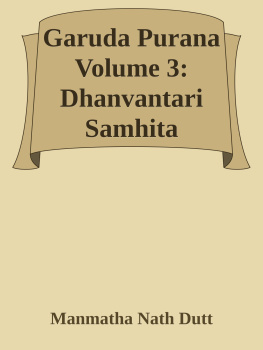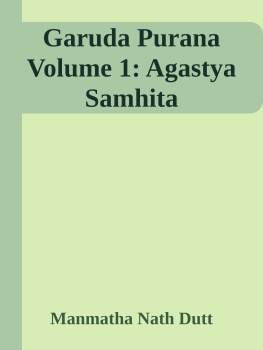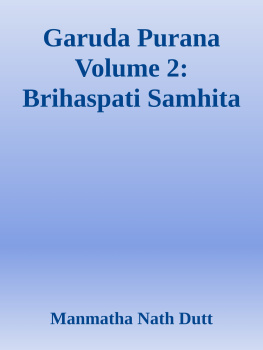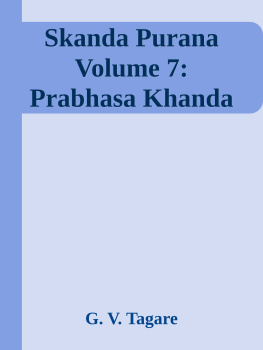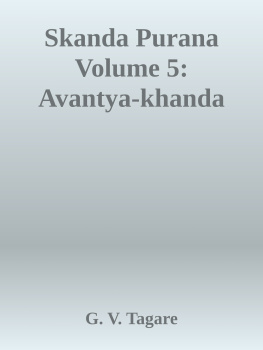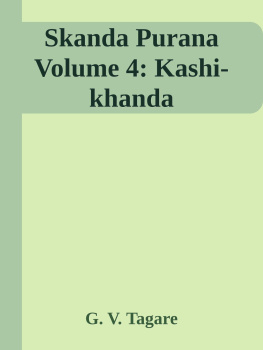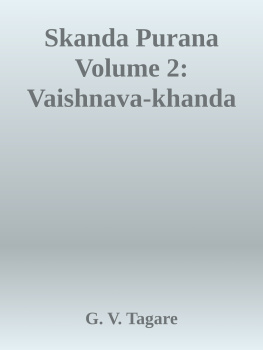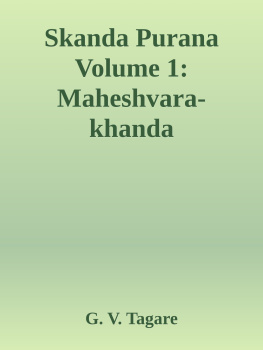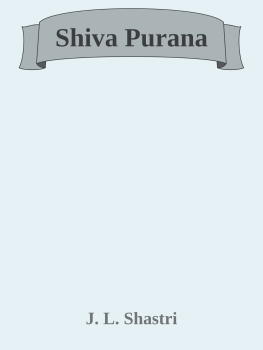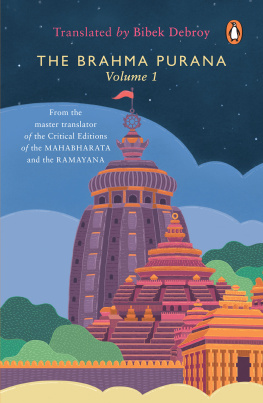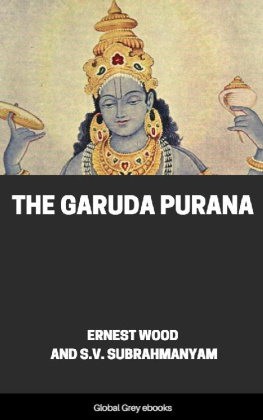Manmatha Nath Dutt - Garuda Purana Volume 3: Dhanvantari Samhita
Here you can read online Manmatha Nath Dutt - Garuda Purana Volume 3: Dhanvantari Samhita full text of the book (entire story) in english for free. Download pdf and epub, get meaning, cover and reviews about this ebook. genre: Religion. Description of the work, (preface) as well as reviews are available. Best literature library LitArk.com created for fans of good reading and offers a wide selection of genres:
Romance novel
Science fiction
Adventure
Detective
Science
History
Home and family
Prose
Art
Politics
Computer
Non-fiction
Religion
Business
Children
Humor
Choose a favorite category and find really read worthwhile books. Enjoy immersion in the world of imagination, feel the emotions of the characters or learn something new for yourself, make an fascinating discovery.
- Book:Garuda Purana Volume 3: Dhanvantari Samhita
- Author:
- Genre:
- Rating:3 / 5
- Favourites:Add to favourites
- Your mark:
- 60
- 1
- 2
- 3
- 4
- 5
Garuda Purana Volume 3: Dhanvantari Samhita: summary, description and annotation
We offer to read an annotation, description, summary or preface (depends on what the author of the book "Garuda Purana Volume 3: Dhanvantari Samhita" wrote himself). If you haven't found the necessary information about the book — write in the comments, we will try to find it.
Garuda Purana Volume 3: Dhanvantari Samhita — read online for free the complete book (whole text) full work
Below is the text of the book, divided by pages. System saving the place of the last page read, allows you to conveniently read the book "Garuda Purana Volume 3: Dhanvantari Samhita" online for free, without having to search again every time where you left off. Put a bookmark, and you can go to the page where you finished reading at any time.
Font size:
Interval:
Bookmark:
The genesis or appearance of a disease in a particular part of the human body, either through the upward, downward, oblique, or transverse movement of the morbific principles, such as the deranged nerve force (
Now I shall discourse on the combination of the deranged Vayu, Pittam and Kapham. Ingestion of insufficient, indigestible, irregular and incompatible meals, use of stab wine, dried potherbs, green radish, and fetid or dry fish, sudden change of food and drink, contrary or unnatural seasons, exposure to the east wind, sudden change of ones mode of living, partaking of raw, uncooked food accumulation of phlegm in the body, malignant influence exerted by ones natal star, false dealings and evil doings, non-gratification of any mental or bodily hankering, and the puerperal conditions of women are the factors, which help the combination and concerted action of the deranged Vayu, Pittam and Kapham. In each disease, the Vayu, Pittam and Kapham produce chemical changes in the blood according to the nature of the disease they give rise to and their characterestic symptoms.
:
The yurveda recognises both the laws of similars and contraries in the domain of practical therapeutics. The fact that a drug, which can induce a disease similar in character to the one under observation is curative to it, was discovered by the savants of Indian medicine long before the birth of Hanemann, or of Homopathy in Europe.
:
The term Vyu, Pittam and Kapham have been very loosely used by the Ayurvedic Physiologists to designate two different sets of substances. In one acceptance, Vyu, Pittam and Kapham mean nerve force, metabolism, and unutilised products of the body; while in another, they signify gas, bile and phlegm,T. R.
The Nidanam of Fever [Chapter CXLVII].
The type due to the action of the deranged Kapham, is marked by nausea, vomiting., cough, numbness of the body, coldness of the skin, and appearance of rashes or eruptions on the body. As birth, growth, and death are natural to all created beings, so aggravation and amelioration are natural to all types of fever. Indigestion with a non-relish for food, numbness of the body, lassitude, a burning sensation in the region of the heart, restlessness (the patient finding no relief in any position whatsoever), non-evacuation of stool and other deranged principles, salivation, nausea, loss of appetite, tasteful moisture in the mouth, heat and gloss of the skin, heaviness of the body, constant urination, and natural fulness of the body, are the symptoms, which mark the type known as ama-contracted through any foul contagion, or engendered through the potency of any spell1, magic, or incantation, as well as those which are due to burns or scalds, are usually grouped under the traumatic head of fevers and owe their origin to extrinsic causes. Extreme fatigue or exhaustion brings on a type of fever in which the enraged and aggravated Vayu affects the vascular process of the organism, and produces pain, swelling and discolouring of the skin. Anger, fright,, bereavement, passion of love, exhalations of poisonous drugs, dusts of flowers, narcotics and the baneful influence cast by malignant planets may engender types of fever, which may' be grouped under the traumatic head, and in which the patient laughs, weeps- or raves like a maniac in succession. The type of fever caused by the odours or exhalations of any drug or cereal is marked by headache, vomiting, epileptic fits and wasting, etc., while the one, due to the effects of any poison, develops dysentery, epilepetic fits, vertigo with a yellowish black clour of the skin, and a burning sensation in. the body.
Palsy and pain in the head are the symptoms, which-mark the case of fever due to anger, while delirium and palsy characterise the one due to the conjoint effects of fright and rage. Fever, which has its origin in the ungratifed Sexual desire, develops such symptoms as loss of consciousness or absent-mindedness, with somnolence, impatience, shyness, and a non-relish for food'. In fever due either to the influence of malignant stars, or to the concerted action of the three morbific principles of Vayu, Pittam and Kapham (Sannipata) both the Vayu and the Pittam of the organism are simultaneously enraged. The types of Sannipatika fever caused through the dynamics of a curse or an incantation, are simply unbearable in their intensity. Incases of spell-origined fever the patient should be basked in the glare of the sacrificial fire (Homagni) into which libations of clarified butter should be cast by reciting the -Mantram. The two last named types of fever are usually ushered in by the appearance of a large crop of bilious eruptions on the skin, great restlessness, fainting fits, and the absence of any distinctive knowledge regarding the different quarters of the heaven. The patient tosses about in the bed in intense agony, and the heat goes on increasing day after day. Thus the premonitory symptoms of the eight forms of fever have been briefly described.
All types of fever are either mental or physical, superficial or affecting the deeper principles of the organism, and mild or virulent. Similarly they may be grouped under two broad sub-divisions such as mature or immature, and Epidemic or sporadic.
A paroxysm of bodily fever first affects the body, whereas it first invades the mind in a case of the mental type. In cases of fever due to the action of the deranged Kapham (cold or catarrhal fever), the deranged Vayu, in conjunction with the deranged Kapham, produces rigor and horripilation, whereas the combination of the deranged Pittam in such cases is witnessed as the burning sensation in the body.
Contrary symptoms such as hyperperaxia with loose motions of the bowels are manifest in a case of Sannipatika fever only on account of the simultaneous derangement of the different morbific principles of the body of a contrary character. In cases of Vahirlinga Sannipata all the symptoms are restricted to the external or superficial principles of the organism, and therefore they become fully patent.
The organic Vayu becomes deranged during the rainy season ( fever breaking out in autum or spring are said to be natural. In fever due to the action of the deranged Pittam and which breaks out in autum, the Kapham lies subservient to the deranged Pittam. Accordingly the patient may be safely advised to fast in the case of fever which is due to the concerted action of the deranged Pittam and Kapham. In spring, the deranged and aggravated Kapham, in conjunction with the deranged Vayu and Pittam, gives rise to a type of fever in which the two last named morbific principles of the body remain subordinate to the enraged Kapham.
A paroxysm of fever unattented with any supervening or dreadful symptoms and appearing in a person of unimpaired strength readily proves amenable to medicine, while the one which is accompanied with grave symptoms, and evinces the concerted derangement of all the three morbific principles of the body often finds a fatal termination. The holy sages of yore have thus opined on the subject. The presence of a large concourse of distressing symptoms together with a sense of constant malaise and aching pain in the limbs, constant micturition, intene heat of the body, loss of appetite, non desire for food, and impairment of the digestive function mark a case of immature fever (amajvara or the stage of lever before the resolution of the different morbific principles which lie at its root). Heat, hyperperaxia, waterbrash, delirium, motions of the bowels, vertigo, and rapid breathing indicate that the fever is approaching its crisis (
Font size:
Interval:
Bookmark:
Similar books «Garuda Purana Volume 3: Dhanvantari Samhita»
Look at similar books to Garuda Purana Volume 3: Dhanvantari Samhita. We have selected literature similar in name and meaning in the hope of providing readers with more options to find new, interesting, not yet read works.
Discussion, reviews of the book Garuda Purana Volume 3: Dhanvantari Samhita and just readers' own opinions. Leave your comments, write what you think about the work, its meaning or the main characters. Specify what exactly you liked and what you didn't like, and why you think so.

